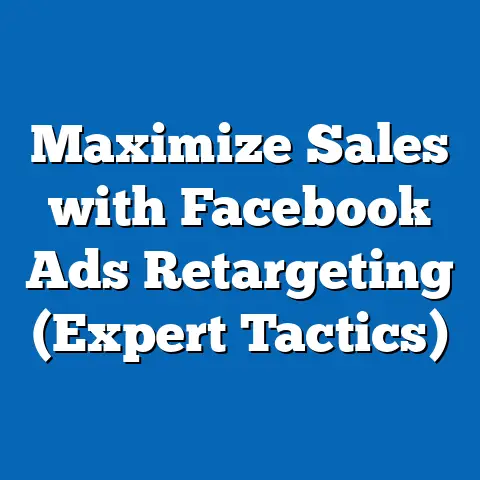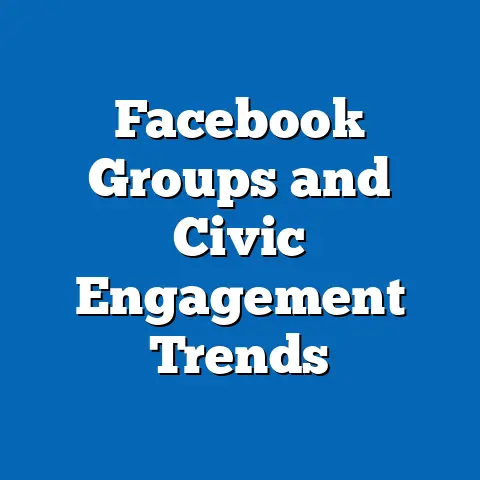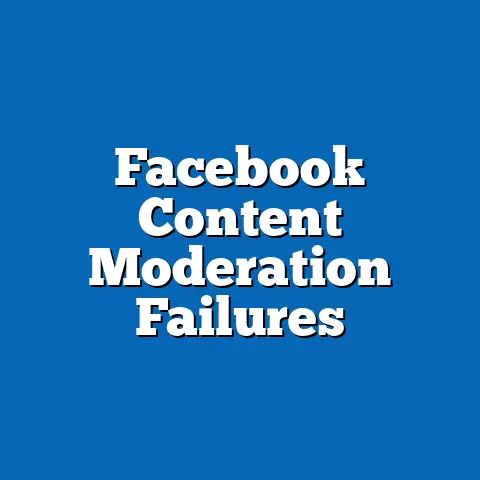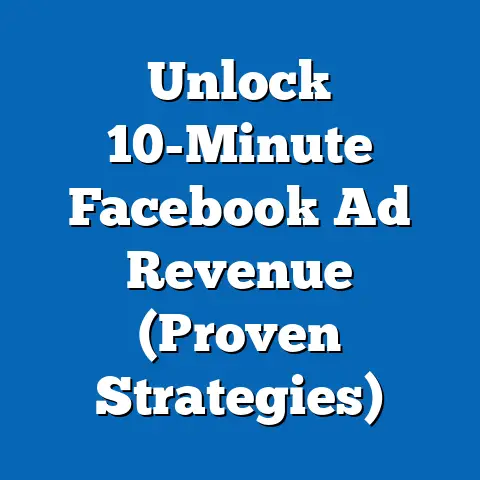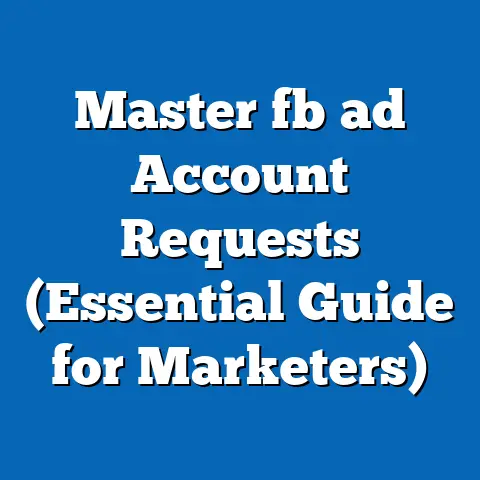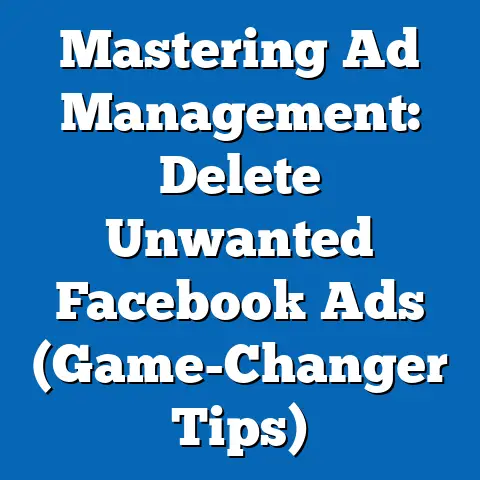Revamp Facebook Ads Campaign Structure (Smart Strategies)
Are you tired of watching your Facebook ad performance plateau or even decline? I know the feeling. It’s like you’re pouring money into a leaky bucket, and no matter how much you add, you’re not seeing the results you expect. The truth is, the Facebook advertising landscape is constantly evolving. What worked six months ago might not cut it today. The platform’s algorithms shift, user behavior changes, and competition intensifies. Many advertisers find themselves struggling to maintain effective campaign performance, facing diminishing returns, and battling increased costs.
I’ve been there myself, scratching my head, wondering why my once-successful campaigns were suddenly underperforming. That’s when I realized I needed a fresh approach, a complete overhaul of my campaign structure. This isn’t just about tweaking a few settings; it’s about fundamentally rethinking how you organize and manage your Facebook ads.
Key Takeaways:
- The Landscape is Evolving: Facebook Ads are constantly changing, requiring continuous adaptation.
- Structure Matters: A well-structured campaign leads to better ad relevance, engagement, and conversions.
- Segmentation is Key: Effective audience segmentation is crucial for reaching the right people.
- Creativity Drives Results: Diversifying ad creatives and formats captures attention and boosts engagement.
- Testing is Essential: A/B testing helps optimize ad performance through data-driven decisions.
- Data Powers Improvement: Facebook Pixel and analytics provide insights to refine targeting and improve conversion rates.
Section 1: Understanding the Current Landscape
Before diving into the “how-to” of revamping your campaign structure, it’s crucial to understand the environment we’re operating in. The world of Facebook Ads isn’t static; it’s a dynamic ecosystem that demands constant learning and adaptation.
Subsection 1.1: The Evolution of Facebook Ads
Facebook Ads have come a long way since their inception. Initially, targeting options were limited, ad formats were basic, and the overall user experience was less sophisticated. Today, we have access to a vast array of tools and features, from granular targeting options to immersive ad formats like Instant Experiences and Augmented Reality ads.
Key Changes in Facebook Ads:
- Targeting: Early days offered basic demographic targeting. Now, we have custom audiences, lookalike audiences, detailed targeting based on interests, behaviors, and more.
- Ad Formats: Static images and text ads have evolved into carousel ads, video ads, collection ads, lead generation ads, and interactive experiences.
- Algorithms: Facebook’s algorithms have become increasingly sophisticated, focusing on delivering ads to users most likely to engage and convert.
- Privacy: Increased focus on user privacy has led to changes like iOS 14 updates, impacting tracking and attribution.
The Growth of Advertisers:
The number of advertisers on Facebook has exploded in recent years. In 2023, Facebook reported over 10 million active advertisers. This growth has significantly increased competition for ad placements, driving up costs and making it harder to stand out.
- Increased Competition: More advertisers vying for the same audience means higher ad costs and lower reach.
- Higher Expectations: Users are bombarded with ads, so your ads need to be highly relevant and engaging to capture their attention.
Subsection 1.2: Common Pitfalls in Current Campaign Structures
One of the biggest mistakes I see advertisers make is sticking to outdated campaign structures. They set up their campaigns once and then leave them running without making necessary adjustments. This can lead to a host of problems.
Common Mistakes:
- Overly Broad Audience Targeting: Targeting too wide an audience can result in wasted ad spend and low conversion rates.
- Lack of Ad Variety: Using the same ad creative repeatedly can lead to ad fatigue, where users stop paying attention to your ads.
- Poor Performance Tracking: Failing to track key metrics and analyze campaign performance makes it impossible to optimize your ads effectively.
- Ignoring Mobile Optimization: With the majority of Facebook users accessing the platform on mobile devices, neglecting mobile optimization can significantly impact your results.
- Not Leveraging Retargeting: Failing to retarget users who have previously engaged with your brand or website can mean missing out on valuable conversion opportunities.
- Neglecting Ad Relevance: Ads that aren’t relevant to the target audience will have low engagement rates and poor performance.
Example of a Pitfall:
Imagine a clothing retailer targeting all Facebook users aged 18-45 with an interest in “fashion.” This audience is incredibly broad, encompassing a wide range of interests, styles, and purchasing behaviors. As a result, the retailer’s ads are likely to be irrelevant to many users, leading to low click-through rates and wasted ad spend.
Impact on Campaign Effectiveness:
These pitfalls can have a significant impact on your overall campaign effectiveness. They can lead to:
- Lower Ad Relevance: Ads are shown to users who are not interested in your product or service.
- Decreased Engagement: Users are less likely to click on or interact with irrelevant ads.
- Increased Ad Costs: You’re paying to show ads to people who are unlikely to convert.
- Lower Conversion Rates: Fewer users are taking the desired action, such as making a purchase or filling out a form.
- Decreased ROI: You’re not getting the return on investment you expect from your advertising efforts.
Takeaway: Understanding the evolution of Facebook Ads and recognizing common pitfalls is crucial for creating effective campaigns. By avoiding these mistakes and adapting your strategies to the current landscape, you can significantly improve your ad performance and ROI.
Section 2: The Importance of a Revamped Campaign Structure
Now that we’ve discussed the challenges and pitfalls of outdated campaign structures, let’s explore the benefits of revamping your approach. A well-structured Facebook Ads campaign can make a world of difference in terms of ad relevance, engagement, and conversions.
Subsection 2.1: Benefits of a Revamped Structure
A revamped campaign structure offers numerous advantages, including:
- Improved Ad Relevance: By segmenting your audience and tailoring your ads to specific groups, you can ensure that your ads are highly relevant to the users who see them.
- Better Audience Engagement: Relevant ads are more likely to capture users’ attention and encourage them to interact with your brand.
- Increased Conversion Rates: When users see ads that are relevant to their interests and needs, they are more likely to take the desired action, such as making a purchase or filling out a form.
- Lower Ad Costs: By targeting the right audience and creating relevant ads, you can improve your ad quality score, which can lead to lower ad costs.
- Higher ROI: A well-structured campaign can generate a higher return on investment by driving more conversions at a lower cost.
- Better Data Insights: A revamped structure allows for more granular tracking and analysis, providing better insights into what’s working and what’s not.
- Increased Scalability: A well-organized campaign is easier to scale and manage as your business grows.
Data and Case Studies:
- Improved Ad Relevance: According to a study by Facebook, ads with high relevance scores are up to 6x more likely to drive conversions.
- Increased Conversion Rates: A case study by HubSpot found that businesses that segment their email lists (a similar concept to audience segmentation) see an average of 14.31% higher open rates and 10.64% higher click-through rates.
- Lower Ad Costs: A report by AdEspresso found that advertisers who use custom audiences and retargeting can reduce their cost per acquisition (CPA) by up to 50%.
Subsection 2.2: Aligning Campaign Goals with Structure
Before you start restructuring your Facebook Ads campaigns, it’s essential to define your campaign goals. What are you trying to achieve with your advertising efforts? Are you trying to increase brand awareness, generate leads, drive sales, or something else?
Common Campaign Goals:
- Brand Awareness: Increase the reach and visibility of your brand.
- Lead Generation: Collect contact information from potential customers.
- Website Traffic: Drive traffic to your website.
- Sales: Generate online or offline sales.
- App Installs: Encourage users to download your mobile app.
- Engagement: Increase likes, comments, shares, and other forms of engagement.
How to Align Campaign Goals with Structure:
- Define Clear Objectives: Start by defining clear, measurable, achievable, relevant, and time-bound (SMART) objectives for your campaigns.
- Choose the Right Campaign Objective: Select the appropriate campaign objective in Facebook Ads Manager that aligns with your goals (e.g., “Awareness,” “Traffic,” “Engagement,” “Leads,” “Sales”).
- Structure Your Campaigns Accordingly: Organize your campaigns, ad sets, and ads in a way that supports your objectives.
Example:
Let’s say your goal is to generate leads for your real estate business. You might structure your campaign as follows:
- Campaign Objective: Lead Generation
- Ad Set 1: Target first-time homebuyers in your local area with ads promoting a free guide to buying a home.
- Ad Set 2: Target renters in your area with ads highlighting the benefits of homeownership.
- Ad Set 3: Retarget website visitors who have viewed your property listings with ads showcasing your latest listings.
Takeaway: Aligning your campaign goals with a strategic campaign structure is crucial for maximizing your results. By defining clear objectives and structuring your campaigns accordingly, you can ensure that your advertising efforts are focused on achieving your desired outcomes.
Section 3: Smart Strategies for Restructuring Your Campaign
Now, let’s get into the nitty-gritty of restructuring your Facebook Ads campaign. Here are some smart strategies you can implement to improve your ad relevance, engagement, and conversions.
Subsection 3.1: Audience Segmentation Techniques
One of the most effective ways to improve your Facebook Ads performance is to segment your audience. This involves dividing your target audience into smaller, more specific groups based on their interests, behaviors, demographics, and other characteristics.
Types of Audience Segmentation:
- Custom Audiences: Create audiences based on your existing customer data, such as email lists, website visitors, and app users.
- Lookalike Audiences: Expand your reach by targeting users who are similar to your existing customers.
- Detailed Targeting: Target users based on their interests, behaviors, demographics, and other characteristics.
1. Custom Audiences:
Custom audiences allow you to target users who have already interacted with your brand. This is incredibly powerful because these users are already familiar with your business and are more likely to convert.
- Email List: Upload your email list to Facebook to target your existing customers with ads.
- Website Visitors: Use the Facebook Pixel to track website visitors and retarget them with ads.
- App Users: Target users who have downloaded and used your mobile app.
- Engagement: Target users who have engaged with your Facebook page, ads, or videos.
2. Lookalike Audiences:
Lookalike audiences allow you to expand your reach by targeting users who are similar to your existing customers. This is a great way to find new customers who are likely to be interested in your product or service.
- Source Audience: Choose a source audience, such as your email list or website visitors.
- Similarity: Select the level of similarity you want in your lookalike audience (e.g., 1% lookalike, 5% lookalike, 10% lookalike).
- Location: Choose the location you want to target with your lookalike audience.
3. Detailed Targeting:
Detailed targeting allows you to target users based on their interests, behaviors, demographics, and other characteristics. This is a great way to reach a specific audience with relevant ads.
- Interests: Target users based on their interests, such as “fashion,” “travel,” or “technology.”
- Behaviors: Target users based on their behaviors, such as “online shopping,” “traveling,” or “using a specific app.”
- Demographics: Target users based on their demographics, such as age, gender, location, education, and income.
- Connections: Target users who are connected to your Facebook page or events.
Practical Tips for Audience Segmentation:
- Start with Your Ideal Customer: Create a detailed profile of your ideal customer, including their interests, behaviors, demographics, and pain points.
- Use Multiple Segmentation Techniques: Combine different segmentation techniques to create highly targeted audiences.
- Test Different Audiences: Experiment with different audiences to see which ones perform best.
- Refine Your Audiences: Continuously monitor and refine your audiences based on their performance.
Example:
Let’s say you’re selling organic skincare products. You might segment your audience as follows:
- Custom Audience: Target your existing customers with ads promoting new products or special offers.
- Lookalike Audience: Create a lookalike audience based on your customer email list to find new customers who are likely to be interested in organic skincare.
- Detailed Targeting: Target users who are interested in “organic skincare,” “natural beauty,” and “eco-friendly products.”
Subsection 3.2: Optimizing Ad Creatives and Formats
In today’s competitive advertising landscape, it’s essential to create ad creatives that capture attention and drive engagement. This involves diversifying your ad formats and experimenting with different visuals, headlines, and calls to action.
Types of Ad Formats:
- Image Ads: Simple and effective for showcasing your product or service.
- Video Ads: Engaging and versatile for telling your brand story.
- Carousel Ads: Allow users to scroll through multiple images or videos.
- Collection Ads: Showcase a catalog of products in a visually appealing format.
- Instant Experiences: Immersive, full-screen experiences that load instantly on mobile devices.
- Lead Generation Ads: Collect contact information from potential customers directly within Facebook.
Tips for Optimizing Ad Creatives:
- Use High-Quality Visuals: Choose images and videos that are visually appealing and relevant to your target audience.
- Write Compelling Headlines: Craft headlines that grab attention and entice users to learn more.
- Create Clear and Concise Copy: Write ad copy that is easy to understand and highlights the benefits of your product or service.
- Use Strong Calls to Action: Tell users what you want them to do (e.g., “Shop Now,” “Learn More,” “Sign Up”).
- Tailor Your Creatives to Each Audience Segment: Create different ad creatives for each audience segment to ensure that your ads are relevant to their interests and needs.
- Test Different Creatives: Experiment with different visuals, headlines, and calls to action to see which ones perform best.
Examples of Successful Campaigns:
- Nike: Uses visually stunning video ads to showcase their products and inspire their audience.
- Airbnb: Uses carousel ads to showcase a variety of unique properties and encourage users to book their next vacation.
- Sephora: Uses collection ads to showcase a catalog of beauty products and drive sales.
Subsection 3.3: Implementing A/B Testing for Continuous Improvement
A/B testing, also known as split testing, is a powerful technique for optimizing your ad performance. It involves creating two or more versions of an ad and testing them against each other to see which one performs best.
How to Set Up Effective A/B Tests:
- Choose One Variable to Test: Focus on testing one variable at a time, such as the headline, image, call to action, or audience targeting.
- Create Two or More Versions of Your Ad: Create two or more versions of your ad, each with a different variation of the variable you’re testing.
- Run Your Test: Run your test for a sufficient amount of time to gather enough data to draw meaningful conclusions.
- Analyze Your Results: Analyze your results to see which version of your ad performed best.
- Implement the Winning Version: Implement the winning version of your ad in your campaigns.
Variables to Test:
Let’s say you want to test two different headlines for your ad:
- Version A: “Get 20% Off Your First Order”
- Version B: “Shop Now and Save 20%”
You would run your test for a sufficient amount of time (e.g., one week) and then analyze the results to see which headline generated the most clicks and conversions.
Subsection 3.4: Utilizing Facebook Pixel and Analytics
The Facebook Pixel is a small snippet of code that you place on your website to track user behavior. This data can be used to create custom audiences, optimize your ads, and measure your results.
Benefits of Using Facebook Pixel:
- Track Website Conversions: See which ads are driving conversions on your website.
- Create Custom Audiences: Retarget website visitors with relevant ads.
- Optimize Ads for Conversions: Tell Facebook to optimize your ads for conversions.
- Measure Your Results: Track your ROI and see how your ads are performing.
How to Implement Facebook Pixel:
- Create a Facebook Pixel: Create a Facebook Pixel in Facebook Ads Manager.
- Install the Pixel Code on Your Website: Install the pixel code on every page of your website.
- Set Up Standard Events: Set up standard events to track specific actions on your website, such as “ViewContent,” “AddToCart,” and “Purchase.”
- Create Custom Conversions: Create custom conversions to track specific goals that are not covered by standard events.
Leveraging Analytics Tools:
In addition to the Facebook Pixel, you can also use other analytics tools, such as Google Analytics, to track user behavior and campaign performance.
How to Use Data to Refine Targeting and Improve Conversion Rates:
- Analyze Your Website Traffic: Use Google Analytics to see where your website traffic is coming from and how users are interacting with your website.
- Track Your Conversion Rates: Monitor your conversion rates to see which ads and landing pages are performing best.
- Identify Your Best Customers: Analyze your customer data to identify your best customers and create lookalike audiences.
- Refine Your Targeting: Use the data you collect to refine your targeting and ensure that you’re reaching the right people with the right ads.
Takeaway: Audience segmentation, ad creative optimization, A/B testing, and data analysis are essential strategies for restructuring your Facebook Ads campaign. By implementing these techniques, you can improve your ad relevance, engagement, and conversions, leading to a higher ROI.
Section 4: Real-Life Success Stories
Let’s take a look at some real-life examples of businesses that have successfully revamped their Facebook Ads campaign structures and achieved significant results.
Subsection 4.1: Case Study 1: E-commerce Brand Boosts Sales by 30% with Targeted Retargeting
Business: An e-commerce brand selling handmade jewelry.
Initial Challenges:
- Low conversion rates from initial ad campaigns.
- High ad costs and low ROI.
- Difficulty reaching the right audience.
Strategies Implemented:
- Audience Segmentation: Created custom audiences based on website visitors, past purchasers, and email subscribers.
- Retargeting: Implemented retargeting campaigns to target users who had viewed specific products or added items to their cart but didn’t complete the purchase.
- Ad Creative Optimization: Developed visually appealing ad creatives showcasing their jewelry, with personalized messaging based on the user’s past behavior.
- A/B Testing: Continuously tested different headlines, images, and calls to action to optimize ad performance.
Measurable Outcomes Achieved:
- Increased sales by 30%.
- Reduced ad costs by 20%.
- Improved ROI by 40%.
Key Takeaways:
- Retargeting is a powerful tool for driving conversions.
- Personalized messaging can significantly improve ad performance.
- Continuous A/B testing is essential for optimizing your campaigns.
Subsection 4.2: Case Study 2: Local Restaurant Generates 50% More Reservations with Hyperlocal Targeting
Business: A local restaurant looking to increase reservations.
Initial Challenges:
- Low brand awareness in the local community.
- Difficulty attracting new customers.
- High reliance on traditional advertising methods.
Strategies Implemented:
- Hyperlocal Targeting: Targeted Facebook users within a 5-mile radius of the restaurant.
- Ad Creative Optimization: Created visually appealing ad creatives showcasing their menu items and highlighting special offers.
- Lead Generation Ads: Used lead generation ads to collect contact information from potential customers and offer them exclusive discounts.
- Event Promotion: Promoted special events and live music performances on Facebook to drive traffic to the restaurant.
Measurable Outcomes Achieved:
- Increased reservations by 50%.
- Improved brand awareness in the local community.
- Attracted a new customer base.
Key Takeaways:
- Hyperlocal targeting can be highly effective for local businesses.
- Visually appealing ad creatives can attract attention and drive engagement.
- Lead generation ads can be used to collect contact information from potential customers.
Conclusion
In today’s ever-changing digital landscape, adapting your Facebook Ads campaign structure is crucial for success. By implementing the smart strategies discussed in this guide, you can improve your ad relevance, engagement, and conversions, leading to a higher ROI.
Key Strategies to Remember:
- Audience Segmentation: Divide your target audience into smaller, more specific groups based on their interests, behaviors, demographics, and other characteristics.
- Ad Creative Optimization: Diversify your ad formats and experiment with different visuals, headlines, and calls to action.
- A/B Testing: Continuously test different versions of your ads to see which ones perform best.
- Data Analysis: Use the Facebook Pixel and other analytics tools to track user behavior and campaign performance.
Take Action:
Now it’s time to take action and implement these strategies in your own Facebook Ads campaigns. Start by defining your campaign goals and then restructure your campaigns accordingly. Experiment with different audience segments, ad creatives, and testing methods to see what works best for your business.
Share Your Experiences:
I encourage you to share your experiences and insights on revamping your Facebook Ads campaign structures. What strategies have worked best for you? What challenges have you faced? Share your thoughts in the comments below and let’s learn from each other!

